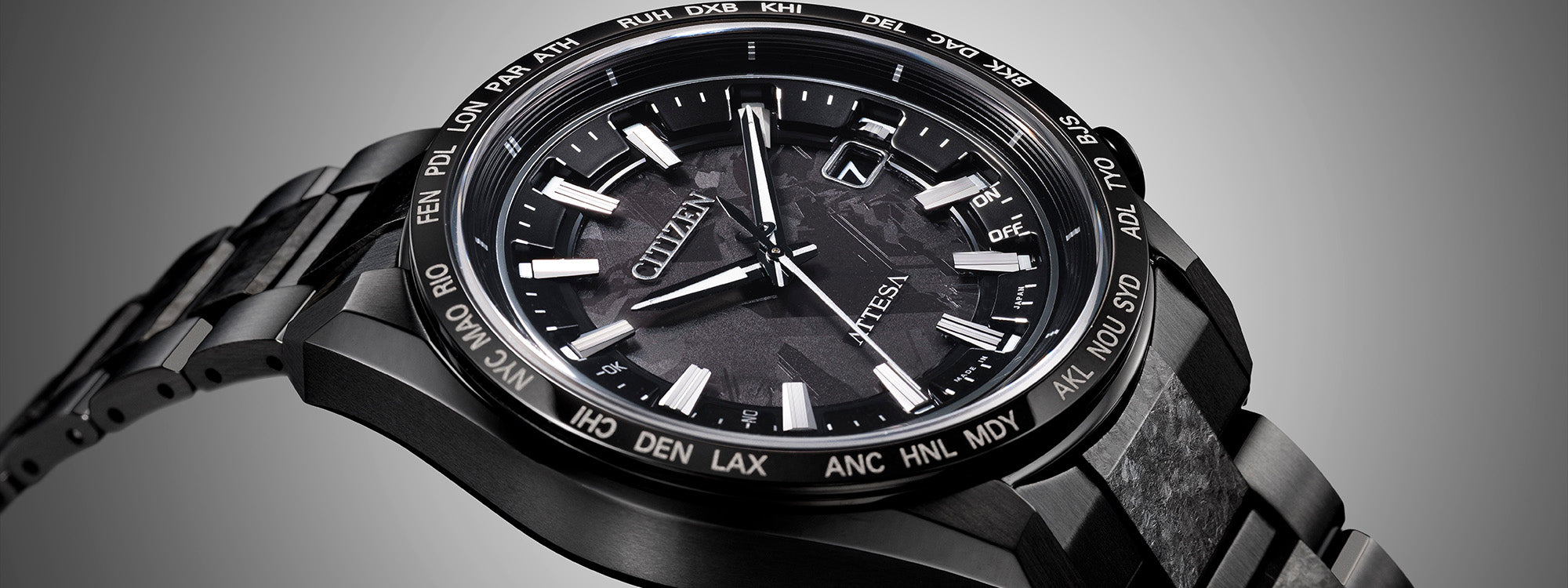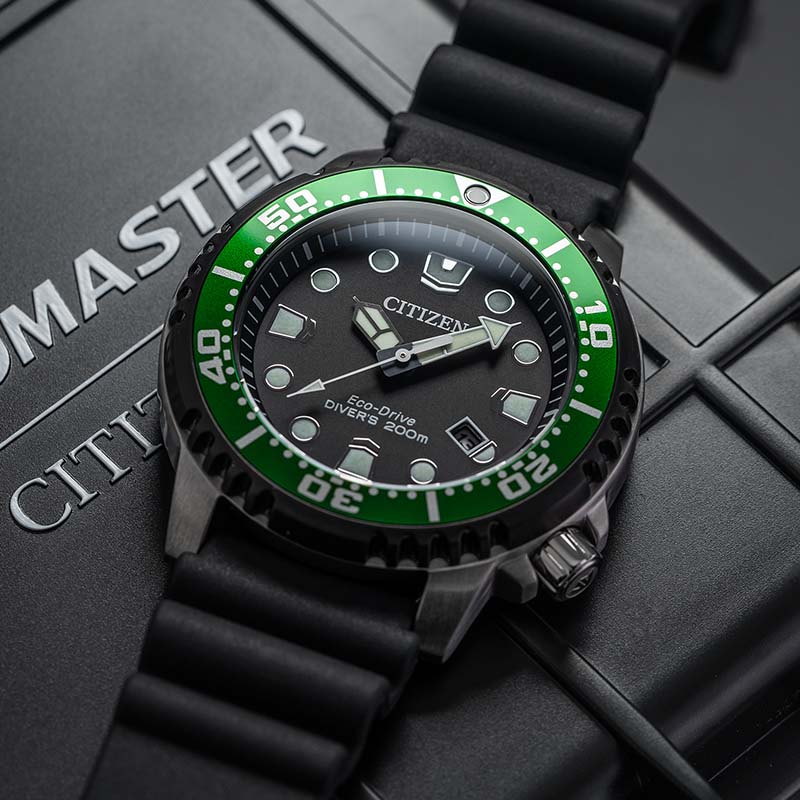The first Citizen titanium watch hit the market more than 50 years ago, and while it probably didn’t receive the breathless coverage that it may have garnered in today’s watch media, it was a watershed moment for the industry. Many watch brands make titanium watches today, but few of them have made the metal a signature of its identity to the extent that Citizen has, and fewer still have even attempted what the Japanese watchmaking giant has achieved in terms of improving and plumbing the full, unrealized potential of titanium. In this feature, we explore Citizen’s history in titanium watches and spotlight some of its most historic pieces, from 1970 to today.

Long before it entered the watchmaking arena in the late 20th Century, titanium had played a role in numerous industrial developments. It was first discovered in 1791 by clergyman and mineralogist William Gregor, in Cornwall, Great Britain, and named several years later by German chemist William Kaproth, who had previously discovered Uranium. Like the latter element, named for the Greek god (and planet) Uranus, titanium’s name comes from a mythological source, the Titans who preceded the Olympian gods. Some of its earliest applications as a mineral ore included titanium dioxide, in products like white pigment, and titanium tetrachloride, in hydrochloric acid and smoke screens.

Later, alloyed with metals like iron, molybdenum, aluminum, and vanadium, titanium became prized for its high strength-to-weight ratio, low density, high melting point, lustrous metallic color, resistance to magnetism, and low electrical and thermal conductivity. All of these properties ultimately made titanium a metal of choice in military applications, particularly in submarines and aircraft, while its hypoallergenic qualities made it ideal for medical and surgical equipment.

While all of these attributes are no doubt what made titanium desirable for use in watchmaking — by Citizen and eventually by other manufacturers that would follow — the challenges involved in working with the material are likely what discouraged its adoption for a long time. Then as now, titanium is extremely difficult to machine and to polish. Because of its poor thermal conductivity and natural elasticity, it is very hard to cut except at extremely high temperatures; the resulting heat buildup can damage both the material and the tools used to shape it.

Titanium’s “gummy” surface in its pure form can also cause cutting tools to be dulled and damaged, and the metal might even stick to the tools. Its hardness can make tool edges deflect off the surfaces, chipping the material in a process called “chatter” and creating shavings that are highly combustible. Because of these and other issues, and the costs associated with solving them, watch manufacturing companies kept a wide berth from titanium for many years, even after the widespread adoption of stainless steel, until Citizen Watch Company — founded in Japan in 1918, and already known throughout the industry for its pioneering technical spirit — took up the gauntlet in the 1960s.

In 1970, Citizen became the first watchmaker to release a watch with a case made entirely of titanium, the short-lived, electronic X-8 Chronometer (above). The timing of this historic release was apropos: the strong, lightweight, corrosion-resistant metal had gained a higher profile in the manufacturing world at the time thanks to its use in the aerospace industry, including vehicles for the Apollo missions that had recently landed astronauts on the moon. The X-8 Chronometer — “X” for the unknown, “8” representing infinity, thus symbolizing infinite possibilities — was outfitted with Citizen’s battery-powered electronic Caliber 0820, which used a balance wheel like a traditional mechanical movement; remember, this was in the very early days of quartz oscillators and many years before Citizen invented Eco-Drive. It was mounted on a leather strap, which left the door open for the title of first fully titanium watch, claimed by the IWC Porsche Design Titan Chronograph in 1980. That watch used titanium for the bracelet as well as the case, and nudged open the door for other Swiss watch brands to pursue titanium in their product lineups.

Nevertheless, it was Japan’s Citizen that dedicated itself not only to using titanium, but to finding ways of improving and optimizing it for watchmaking, from the jump. In 1982, a year that also saw the first watches in Citizen’s Promaster collection, the Japanese watchmaker released the 1300M Professional Dive Watch, which was not only its first divers’ watch in a titanium case but also the record-setter at the time for the world’s most water-resistant watch in serial production. (rated to the 1,300 meters alluded to in its name). The use of lightweight titanium enabled the case to be huge (47mm) as well as very unconventional in design (squared corners with visible screws, four flanges, screw-down crown on the left). The movement was another pre-Eco-Drive quartz caliber. Citizen has revived this design, with some slight modifications, in the current Promaster Eco-Drive 200M models (above).

The next major step came in 1987, with the release of the original Attesa watch (above). Intended as the launchpad for a line of watches that would “utilize the unique look of titanium,” the Attesa took its name from the Italian word for “expectation.” Very unusual and minimalist in its look by today’s Citizen standards, the Attesa had both its case and its sleek, integrated monolink bracelet made of titanium, which was treated with a newly developed processing technology that imparted a softly metallic, almost glowing finish to the surfaces. It was a departure from the aesthetic of most titanium watches, which traditionally have a duller, matte finish. The mastery of this process proved to be the harbinger of other advancements Citizen would make with titanium.

With the dawning of a new millennium, Citizen ushered in a new era for its titanium watches. In 2000, the company introduced the ASPEC World Time model (above), its first titanium-cased timepiece that utilized Citizen’s proprietary surface-hardening technology, called Duratect. Titanium is a naturally soft metal and scratches easily compared to stainless steel, and the two-step Duratect process strengthens both of these aspects by first thoroughly refining, or “cleaning,” the surface of the metal so it can be more easily polished and then applying a layer that enhances the scratch resistance. Citizen employees wore samples of the Duractect-treated watches over the course of a 10-year period of research and development and at the end of that stretch they were in near-mint condition compared to the non-treated samples, Another attribute of Duratect, perhaps unexpected at the start of this decade-long quest, is that Duratect-treated titanium can take on a range of colors in addition to its gleaming, mirror-polished surface. Citizen coined the now-familiar term “Super Titanium” for the metal, whose scratch-resistant surface is five times harder than that of stainless steel.

Citizen explored the possibilities of Super Titanium further in 2006 with the launch of the Promaster Eco-Drive radio-controlled watch, a timepiece that also represented another evolution of Citizen’s multi-band, radio-controlled atomic timekeeping technology, which it had pioneered in 1993 and had been streamlining ever since. This watch (pictured above) was the first to incorporate both the Duratect MRK process, which hardens the titanium by injecting it with nitrogen and oxygen gases, and the Duratect DLC treatment, which uses a low-temperature plasma injection technology to create an amorphous hard film, composed mostly of carbon and hydrogen, which further enhances the surface. Altogether, the finishing renders to the Super Titanium case and bracelet a hardness of 1,300 to 1,500 on the Vickers scale; for comparison, 316L stainless steel has a 180 - 210 Vickers hardness and grade 5 titanium, the standard for most of the rest of the watch industry, is under 400 on the scale.

Fast forward another 10 years, and we see the debut of Duratect Sakura Pink, a treatment that takes its pale pink-golden color, and its name, from the cherry blossoms (“Sakura” in Japanese) that bloom in fragrant clouds in the springtime. It was yet another attention-grabbing hue for Citizen’s Super Titanium that brought an elevated level of warm elegance to the well-established hardness and scratch-resistance of the DLC-treated metal. In that same pivotal year, which also marked the 40th anniversary of its game-changing Eco-Drive movements, Citizen unveiled the first Eco-Drive One, which remains the world’s thinnest light-powered analog watch. Housing a record-setting Eco-Drive movement just 1.00mm thick, the original model’s case was made of a ceramic composite material called Cermet and measured just 2.98mm thick. Two years later, Citizen put its ultra-thin, super-accurate movement inside a case made of Super Titanium that was only slightly thicker, at 3.53mm.

Citizen wasn’t finished with new colors and even surface textures for its Duratect-coated Super Titanium. The all-titanium Attesa family added a model in 2019 that debuted Duratect MRK Gold, a new treatment that rendered the Super Titanium case even more resistant to scratches and dents, with a Vickers hardness of up to 1,500 Hv, while also giving it a luxurious, gleaming appearance for a fraction of the cost of what the same watch would have cost in actual precious metal. For the 50th anniversary of its foray into titanium watchmaking, in 2020, Citizen launched a special edition (above) from its Satellite Wave GPS series, which melds cutting-edge, satellite-driven timekeeping, multifunctional capabilities (in this case, including a world-timer and a chronograph), and the proprietary light-powered Eco-Drive charging for the movement. The Citizen Titanium Technology 50th Anniversary Satellite Wave GPS F950 (a mouthful of a name, but a rather short production run, limited to 550 pieces) featured a Super Titanium case and bracelet with a predominantly anthracite-brushed finish, with highlight elements in Sakura pink gold.

The watch industry in this day and age loves to mark anniversaries with new releases, and for Citizen, another of these milestones beckoned in 2022: the 35th anniversary of the first Attesa watch and, accordingly, another opportunity to showcase the maker’s continued mastery of titanium. One notable example emerged from Citizen’s partnership with iSpace, the sponsor of Hakuto-R, a Japanese moon exploration mission that uses the watchmaker’s Super Titanium for components of its lunar lander. The Attesa Hakuto-R watch, limited to 1,000 pieces and pictured above, is clad in the same metal but on this model.Citizen also offers yet another a world’s first interpretation of it: the bezel and center links are made in “recrystallized” titanium, whose distinct, uneven, crystalline patterns are created by heating and then rapidly cooling the metal. The effect is somewhat akin to a carbon fiber or forged carbon look, but with all of Super Titanium’s attributes.

Also making its debut in 2022, and similarly inspired by the Hakuto-R partnership, was yet another attention-riveting colorway in the expanding Super Titanium palette. The so-called “Blue Universe” collection (above) consists of three new Attesa models, all bearing Super Titanium bezels and bracelet center links in the new Duratect DLC Blue tone, which Citizen’s engineers achieved through a complex thin-film interference process — in essence, duplicating the process in nature that makes rainbow colors appear on the surface of soap bubbles — that yields a deep and shiny blue color. The blue details harmonize with the watches’ predominantly glossy black finish for a suitably sleek and undeniably “cosmic” look — most pronounced in the sparkling effect applied to the dials, evoking the starry firmament of outer space.

Early in 2025, Citizen (a brand whose history I have covered in the past) introduced its first Super-Titanium Attesa models with ceramic bezels, thus marrying two watchmaking materials prized both for their hardness and lightness, and followed those up with yet another pioneering colorway, Duratect Amber Yellow, a more yellow-goldish hue of the surface-hardened metal in comparison to the more rose-gold-tinted Sakura pink. The latter made its debut, on the ladies' model shown above, at the opening of a traveling exhibit in New York City, called "Super Titanium: The Beauty of Time," dedicated to showcasing more than half-century of developments and prominent timepieces since Citizen first ushered titanium into horological circles. Fifty-five years into its grand experiment with titanium, it's clear that Citizen Watch Company is far from finished in taking it to new and even more Super heights. You can learn more at citizenwatch.com.





















































0 Comments